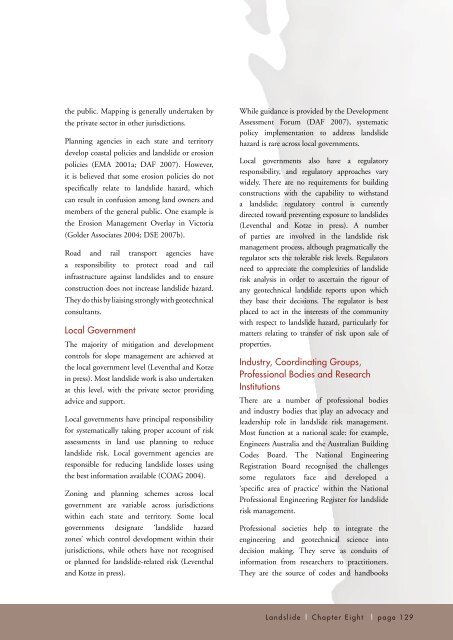Landslide - Geoscience Australia
Landslide - Geoscience Australia
Landslide - Geoscience Australia
You also want an ePaper? Increase the reach of your titles
YUMPU automatically turns print PDFs into web optimized ePapers that Google loves.
the public. Mapping is generally undertaken by<br />
the private sector in other jurisdictions.<br />
Planning agencies in each state and territory<br />
develop coastal policies and landslide or erosion<br />
policies (EMA 2001a; DAF 2007). However,<br />
it is believed that some erosion policies do not<br />
specifically relate to landslide hazard, which<br />
can result in confusion among land owners and<br />
members of the general public. One example is<br />
the Erosion Management Overlay in Victoria<br />
(Golder Associates 2004; DSE 2007b).<br />
Road and rail transport agencies have<br />
a responsibility to protect road and rail<br />
infrastructure against landslides and to ensure<br />
construction does not increase landslide hazard.<br />
They do this by liaising strongly with geotechnical<br />
consultants.<br />
Local Government<br />
The majority of mitigation and development<br />
controls for slope management are achieved at<br />
the local government level (Leventhal and Kotze<br />
in press). Most landslide work is also undertaken<br />
at this level, with the private sector providing<br />
advice and support.<br />
Local governments have principal responsibility<br />
for systematically taking proper account of risk<br />
assessments in land use planning to reduce<br />
landslide risk. Local government agencies are<br />
responsible for reducing landslide losses using<br />
the best information available (COAG 2004).<br />
Zoning and planning schemes across local<br />
government are variable across jurisdictions<br />
within each state and territory. Some local<br />
governments designate ‘landslide hazard<br />
zones’ which control development within their<br />
jurisdictions, while others have not recognised<br />
or planned for landslide-related risk (Leventhal<br />
and Kotze in press).<br />
While guidance is provided by the Development<br />
Assessment Forum (DAF 2007), systematic<br />
policy implementation to address landslide<br />
hazard is rare across local governments.<br />
Local governments also have a regulatory<br />
responsibility, and regulatory approaches vary<br />
widely. There are no requirements for building<br />
constructions with the capability to withstand<br />
a landslide; regulatory control is currently<br />
directed toward preventing exposure to landslides<br />
(Leventhal and Kotze in press). A number<br />
of parties are involved in the landslide risk<br />
management process, although pragmatically the<br />
regulator sets the tolerable risk levels. Regulators<br />
need to appreciate the complexities of landslide<br />
risk analysis in order to ascertain the rigour of<br />
any geotechnical landslide reports upon which<br />
they base their decisions. The regulator is best<br />
placed to act in the interests of the community<br />
with respect to landslide hazard, particularly for<br />
matters relating to transfer of risk upon sale of<br />
properties.<br />
Industry, Coordinating Groups,<br />
Professional Bodies and Research<br />
Institutions<br />
There are a number of professional bodies<br />
and industry bodies that play an advocacy and<br />
leadership role in landslide risk management.<br />
Most function at a national scale: for example,<br />
Engineers <strong>Australia</strong> and the <strong>Australia</strong>n Building<br />
Codes Board. The National Engineering<br />
Registration Board recognised the challenges<br />
some regulators face and developed a<br />
‘specific area of practice’ within the National<br />
Professional Engineering Register for landslide<br />
risk management.<br />
Professional societies help to integrate the<br />
engineering and geotechnical science into<br />
decision making. They serve as conduits of<br />
information from researchers to practitioners.<br />
They are the source of codes and handbooks<br />
<strong>Landslide</strong> | Chapter Eight | page 129

















